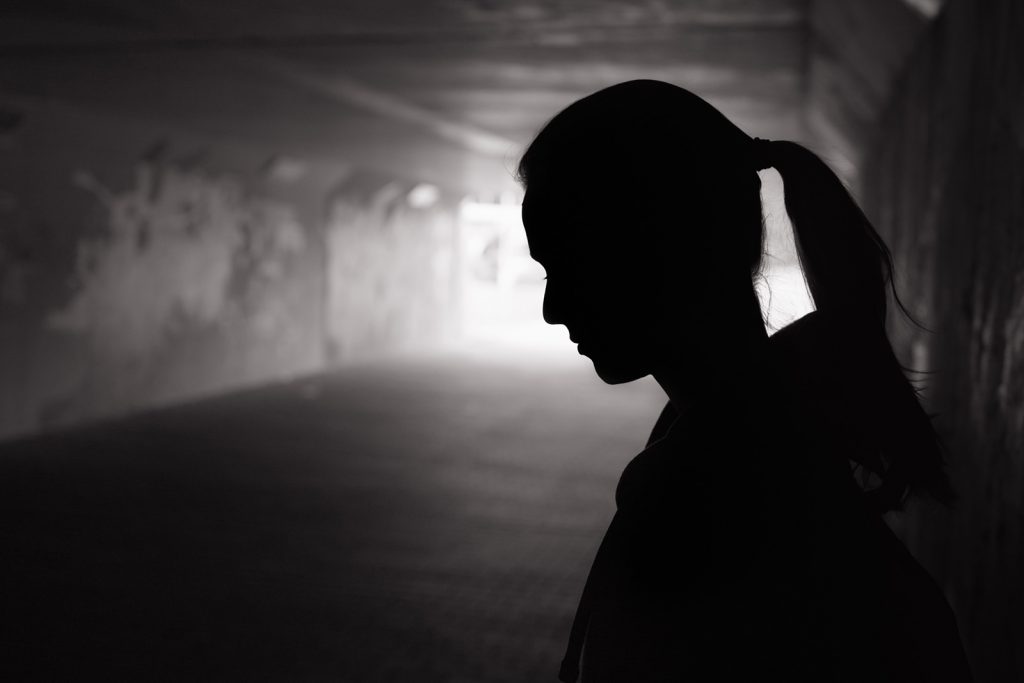What is human trafficking?
Human Trafficking is defined as recruiting, transporting, transferring, receiving, holding, concealing or harbouring a person, or exercising control direction or influence over the movements of a person, to exploit them or to assist in facilitating their exploitation (sections 279.01 and 279.011 of the Canadian Criminal Code).
Traffickers control their victims in various ways such as taking away their identity documents and passports, sexual abuse, threats, intimidation, physical violence, and isolation.
Victims suffer physical or emotional abuse and often live and work in terrible conditions.

Sex Trafficking
Trafficked persons are often lured and groomed by people posing as boyfriends or girlfriends and are forced to hand over most, or all, of the money associated with these sexual acts. Once lured, violence and threats of violence are often used as a means of control to force trafficked persons to perform sexual services.
Debt bondage often results from gifts, expensive clothes and drugs that are supplied to the trafficked person by the trafficker during the recruitment phase.
Sex Trafficking can affect anyone – girls and boys, women and men – anytime, anywhere.

Labour Trafficking
Labour traffickers – including recruiters, contractors, employers, and others – use violence, threats, lies, debt bondage, or other forms of coercion to force people to work against their will in many different industries.
Trafficked persons are often promised high-paying jobs, education or travel opportunities; however, when they arrive they are forced to work long hours under unsafe and very poor working conditions for little or no money. Labourers are often forced to pay back large (illegal) recruitment fees that are separate from the immigration services fee they can legally be charged.
Traffickers exert complete physical and psychological control over their survivors/victims by using abuse, threats, debt bondage, document and money confiscations. Traffickers will lie to individuals and tell them that if they do anything inconsistent with their work permits they could lose status and/or face deportation. Many endure the abuse as they have families and children to support in their home countries.
Men, women, and children have been survivors/victims of forced labour in Canada. Domestic servitude is a type of labour trafficking where trafficked persons are forced to clean houses, do laundry and other domestic chores, care for children and elderly family members, and are often called upon to be available at all times of the day or night. They receive very little or no pay for their work.
In some cases, trafficked persons are underfed and show signs of malnourishment. They may not speak English, no longer have possession of their travel documents or ID. They are often unaware of their rights in Canada or how to get assistance.
Potential signs of Human Trafficking:
- Being controlled by others, driven to and from locations, and escorted at all times;
- Being controlled and watched by others, having someone speak for them in public;
- Not having a passport or other forms of I.D. in their possession;
- Not having control of their own money or cell phone, may have more than one cell phone in their possession;
- Having their Passport and other ID documents confiscated by others;
- Not being familiar with the neighborhood they live or work in;
- Being moved frequently; claim to be “new” or “just visiting”;
- Not being allowed to contact family or friends;
- Lying about age/false ID;
- Providing scripted or rehearsed answers to casual questions;
- May be in possession of excess cash outside their financial means and have hotel keys.
Behavioural Signs:
- Act in a fearful, anxious, submissive or nervous manner, excessive concern about displeasing partner/employer;
- Fearful of law enforcement or immigration services;
- Avoids eye contact, has another person speak for them;
- May have visible signs of substance dependency;
- Expressing fear and intimidation through facial expressions or body language;
- Use slang terminology that is popular within the sex industry subculture (daddy/pimp/ bottom, etc).
Physical Appearance:
- May be dressed in age inappropriate clothing;
- May be dressed in clothing inappropriate for the time of year or context;
- May suddenly have expensive clothing, purses, shoes, nail services;
- Branding with tattoos of the trafficker’s name or symbol;
- May have bruises or other signs of physical abuse including the appearance of being malnourished;
- Lacking in basic medical services or is being denied services by employer;
- May show signs of being physically restrained, confined or tortured.
Survivor/Victims may:
- Not know they are being victimized because they have a relationship with their trafficker – it could be their boyfriend, family member or friend;
- Not appear to need assistance because they have a place to live, food to eat, nice clothes, medical care and even a “paying job”;
- Be unaware of their rights, or may have been intentionally misinformed about their rights so they don’t know they can receive help;
- Be taught to distrust and fear the government and law enforcement officers because they are afraid they will get arrested or deported (if from another country);
- Feel alone, isolated, helpless with nowhere else to turn. Subsequently they will do as they are told;
- Fear for their safety or the safety of someone known to them, as some traffickers will threaten to harm the victim, their friends or family members if they report their situation to, or cooperate with law enforcement;
- Feel as though they have a debt to “pay back” – for things like gifts, drugs, accommodation, recruitment fees etc.; and
- Suffer trauma and psychological effects. In human trafficking related to sexual exploitation, the survivors/victims may be exposed to higher incidences of HIV and sexually transmitted infections.
If you think you may be a survivor / victim of human trafficking.
THERE IS HELP!
Call 911
Call 807-684-1051
Understand why and how human trafficking happens.
Survivor/Victims don’t come forward to the police or organizations for help for a variety of reasons such as:
- Not recognizing that they are a survivor/victim of human trafficking;
- Fear and shame of their experiences;
- Lack of knowledge of their rights, lack of documentation;
- Cannot reach out for help due to language barriers;
- Fearful of law enforcement and lack of trust in organizations that provide support or assistance;
- Threats made to the victim and towards people they know or to their families;
- Foreign Nationals with precarious status may be afraid to report for fear of being deported.
The business of human trafficking is often characterized as a “low risk/high reward activity” because the crime is difficult to detect and investigate. This means that there are relatively low prosecution rates worldwide. Unlike the sale of drugs or guns, human beings can be sold over and over for the financial or material benefit of the traffickers, making this crime extremely lucrative.
Modern justice systems still rely heavily on witness testimony to prove that the trafficking has occurred. Due to the trauma experience during the trafficking, many surivors/victims will have gaps in their memories or become overwhelmed and/or afraid in court.
The United Nations has estimated that this illegal activity generates approximately $32 billion (US) annually for its perpetrators. Recent Global Modern Slavery Index estimates put the number of modern slavery/human trafficking victims at 40 million worldwide (2017).
Tips for friends & family.
Signs that your child could be trafficked:
- Older boyfriend in their lives who is controlling
- Frequently visiting places that are unusual for their age group to attend, such as hotels or motels, clubs etc.
- Dressing more provocatively
- Staying out late or all night
- Hanging out with new friends who are older than them
- Ignoring childhood friends and family members
- Drinking or using drugs
- Skipping school, skipping meals, not showering or stop changing clothes
- Exhibiting anxious behaviour, lack of sleep, depression
- Ignoring rules and instructions at school or at home
- Lying or unable to recall events in their lives
- Carrying false ID, one or more cell phone(s)
- Has expensive or new clothes, shoes or jewellery of unknown origin
- Spending more money and possessing expensive gifts from a new friend or boyfriend
- Talking about a modeling or other job contracts waiting in another town or city
- Becoming more secretive about spending time online or on their cell phone
- Becoming frightened of being online or on cell phone/telephone
The best way to be vigilant and protect your family and friends is by learning the signs and indicators of trafficking and by candidly talking about the possible risks with your kids. Having open, honest discussions about this will go a long way. If your kids encounter an uncomfortable or potentially dangerous situation/person, ensure they have access to a safe adult to report it to.
If you have trouble having these conversations reach out to the resources located on this page to help with being able to provide you with ways to talk to your children and youth about these topics.
Traffickers are using online message boards, social media websites, private messaging chat apps, shopping centres and other public places to recruit potential survivors/victims. Traffickers often connect with children online and begin the process of grooming and luring. They look for vulnerabilities or holes in a young person’s life and try to fill them.
Do they have low self esteem? Traffickers will compliment them and tell them they are good-looking. Do they feel unloved and alone? Traffickers will pose as doting boyfriends and make false promises.
Traffickers and other predators are using Facebook, Twitter, Ask.fm, Whisper, Snapchat, Instagram, TikTok to have direct access to kids.
It’s important for parents to be able to recognize the warning signs and talk about the luring tactics that these criminals use with their children.
There are instances of peer to peer recruitment happening in high schools. Frank discussions around this issue for both male and female children is important. Traffickers will sometimes use older girls to recruit other females by befriending them, and then turning them over to a pimp.
